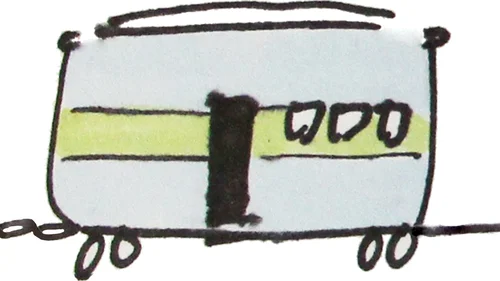Click on the train cars for a 360° view inside.
A breeze whips through the open windows of the mid-1950s engine’s cab. From the driver’s seat Micheal Mullins pokes his head out to check in front and behind the train. The 26-year-old’s long ponytail and beard catch some of the wind. As the train approaches a street crossing, he tugs on a small lever. A deafening series of short and long whistles breaks the silence of an otherwise calm Memorial Day weekend. It’s a sound that can transport Mullins back to his childhood growing up in a small town near Charleston, West Virginia, where a train ran by his neighborhood.
“It was just far enough away that it was like a lullaby at night. It would put you right to sleep,” he says. “Then when we moved away I couldn’t sleep.”
His young fascination morphed into a career as a freight engineer during the weekdays and, at least once a month, as a volunteer engineer for the Hocking Valley Scenic Railway in Nelsonville, Ohio. Under Mullins guidance the passenger train tugs along, tucked beneath a sheet of gray clouds. It travels alongside the Hocking River and passes through backyards with chickens and gardens. Little boys look out the windows with wide eyes and seniors sit back and remember days gone by.
“This is one of my favorite stretches right here,” Mullins says, as the train approaches a verdant hollow. The trees swallow the train for a moment before opening back up. It’s a short two-hour joyride for the passengers aboard.
Inside, junior conductor Hugh Woods, collects and hole punches the passenger’s tickets.
“How are we doing today? Do you have your tickets?” He asks as he approaches a couple. “Is she walking or riding back?” he asks the man as he takes their tickets and gives each two punches.
Depends how she acts when we get to Hadenville,” the passenger replies.
“Alright, well I’ll give you the tickets and you can decide,” Woods says.
Along the ride Woods narrates historical facts about the railroad and the surrounding area. The railroad was built in 1867 to carry salt and coal between Columbus and Athens, Ohio. Later it transported the locally famous starbricks. Passenger service on the rail began a few years later and eventually the line extended to connect to Toledo.
“People can come out and experience that ride they had years ago,” says Bob Baughman, scenic railway president. “This is not Disney Land or a place like that — what you see out the windows is what you’ve seen out the windows when you were riding trains back then.”







